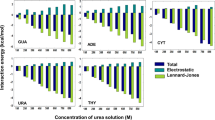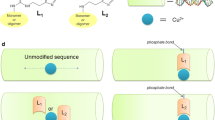Abstract
THE binding of amino acridines to DNA (Fig. 1) has been shown to occur by both a strong and a weak binding process1. The energy and specificity of the strong binding process are too great for the interaction to be purely electrostatic and it has become clear that interaction of the acridine ring with the bases in DNA is involved2–5. Lerman6 postulated that the binding process involved an intercalation of the amino acridines between base pairs in the ordered array of DNA with a consequent extension and local untwisting of the DNA double helix. Estimates have been made by various authors of the extent of untwisting which is possible for the DNA structure and which is required to allow intercalation; these vary from 12° (ref. 7) to 45° (ref. 6, an angle of −9°, in the left-handed sense, between successive base pairs). The plane of the intercalated amino acridines was thought to be perpendicular to the helix axis and this has been verified within the broad limits of the experimental methods8,9. Evidence for extension of the DNA helix on binding amino acridines has been obtained by autoradiography10 and X-ray11,12, sedimentation6 and viscosity6,13 studies. In his 1961 paper, Lerman proposed that the amino acridine was located over a base pair of the DNA (Fig. 2). Denaturation of the DNA disrupts the ordered arrays of base pairs in the double helix, apart from limited local renaturation, and, on the basis of the above intercalation model, would be expected to remove or, at least, greatly to reduce such strong binding. Many observations show that this is not the case and that the strong binding process is not reduced in extent by denaturation; this has been shown for amino acridines14,15 and for similar organic cations16. On the basis of model building studies we wish to propose a modified intercalation model which satisfies these criteria and, in particular, the condition that binding should occur to the same extent on denatured DNA.
This is a preview of subscription content, access via your institution
Access options
Subscribe to this journal
Receive 51 print issues and online access
$199.00 per year
only $3.90 per issue
Buy this article
- Purchase on Springer Link
- Instant access to full article PDF
Prices may be subject to local taxes which are calculated during checkout
Similar content being viewed by others
References
Peacocke, A. R., and Skerrett, J. N. H., Trans. Farad. Soc., 52, 261 (1956).
Michaelis, L., Cold Spring Harbor Symp. Quant. Biol., 12, 131 (1947).
Oster, G., Trans. Farad. Soc., 47, 660 (1951).
Heilweil, H. G., and van Winkle, Q., J. Phys. Chem., 59, 939 (1955).
Weill, G., and Calvin, M., Biopolymers, 1, 401 (1963).
Lerman, L. S., J. Mol. Biol., 3, 18 (1961).
Fuller, W., and Waring, M. J., Ber. Bunsen. Phys. Chem., 68, 805 (1963).
Lerman, L. S., Proc. U.S. Nat. Acad. Sci., 49, 94 (1963).
Houssier, C., Indust. Chim. Belge T 30, No. 3, 235 (1965).
Cairns, J., Cold Spring Harbor Symp. Quant. Biol., 27, 311 (1962).
Luzatti, V., Masson, F., and Lerman, L. S., J. Mol. Biol., 3, 634 (1961).
Neville, D. M., and Davies, D. R., J. Mol. Biol., 17, 57 (1966).
Drummond, D. S., Pritchard, N. J., Simpson-Gildemeister, V. F. W., and Peacocke, A. R., Biopolymers, 8 (1966) (in the press).
Drummond, D. S., Simpson-Gildemeister, V. F. W., and Peacocke, A. R., Biopolymers, 3, 135 (1965).
Liersch, M., and Hartmann, G., Biochem. Z., 343, 16 (1965).
Waring, M., J. Mol. Biol., 13, 269 (1965).
Author information
Authors and Affiliations
Rights and permissions
About this article
Cite this article
PRITCHARD, N., BLAKE, A. & PEACOCKE, A. Modified Intercalation Model for the Interaction of Amino Acridines and DNA. Nature 212, 1360–1361 (1966). https://doi.org/10.1038/2121360a0
Issue Date:
DOI: https://doi.org/10.1038/2121360a0
This article is cited by
-
Effect of structure on antibiotic action of new 9-(ethylthio)acridines
Folia Microbiologica (2002)
-
Quantum mechanical studies on the activity of anticancerous drug — Ellipticine
Journal of Biosciences (1985)
-
Influence of the DNA structure on the free radical induction due to proflavine and light treatment
Radiation and Environmental Biophysics (1979)
-
Selective laser excitation of bases in nucleic acids
Applied Physics (1979)
Comments
By submitting a comment you agree to abide by our Terms and Community Guidelines. If you find something abusive or that does not comply with our terms or guidelines please flag it as inappropriate.



